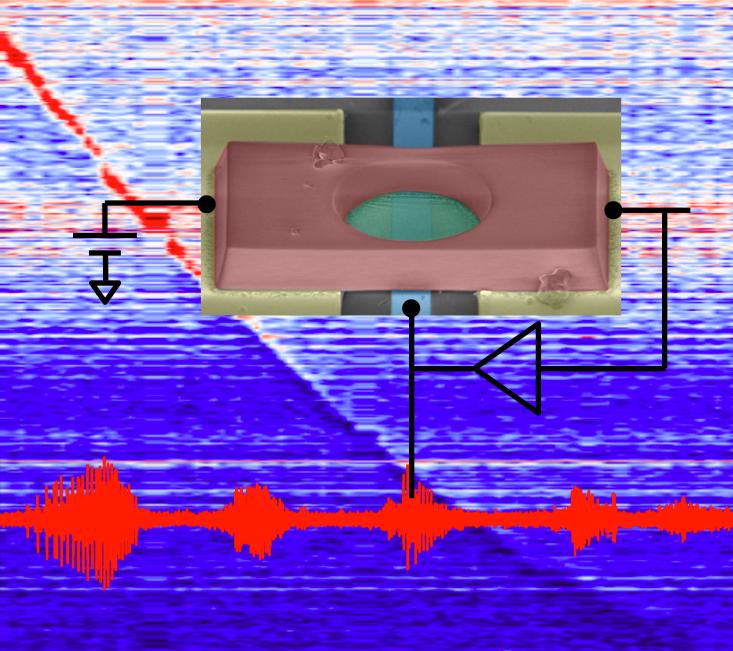World’s smallest FM radio transmitter
Could lead to ultrathin, more-power-efficient cell phones
November 21, 2013

Placing
a sheet of atomically thin graphene into a feedback circuit causes
spontaneous self-oscillation that can be tuned to create frequency
modulated (FM) signals (credit: Changyao Chen, Sunwoo Lee, Columbia
University)
“This is an important first step in advancing wireless signal processing and designing ultrathin, efficient cell phones, Mechanical Engineering Professor James Hone said. The miniaturized devices can also be put on the same chip that’s used for data processing, he added.
NEMS replacing MEMS
Graphene, a single atomic layer of carbon, is the strongest material known to man, and also has electrical properties superior to the silicon used to make the chips found in modern electronics.
The combination of these properties makes graphene an ideal material for nanoelectromechanical systems (NEMS), which are scaled-down versions of the microelectromechanical systems (MEMS) used widely for sensing of vibration and acceleration. For example, Hone explains, MEMS sensors figure out how your smartphone or tablet is tilted to rotate the screen.
In this new study, the team took advantage of graphene’s mechanical “stretchability” to tune the output frequency of their custom oscillator, creating a nanomechanical version of an electronic component known as a voltage controlled oscillator (VCO).
With a VCO, explains Hone, it is easy to generate a frequency-modulated (FM) signal, which is used for FM radio broadcasting. The team built a graphene NEMS whose frequency was about 100 megahertz, which lies right in the middle of the FM radio band (87.7 to 108 MHz).
They used low-frequency musical signals (both pure tones and songs from an iPhone) to modulate the 100 MHz carrier signal from the graphene, and then retrieved the musical signals again using an ordinary FM radio receiver.
“This device is by far the smallest system that can create such FM signals,” says Hone.
Wireless applications
[+]
While graphene NEMS will not be used to replace conventional radio
transmitters, they have many applications in wireless signal processing.
A
printed circuit board inside a Nokia 3210 cell phone, circa 1999. Most
of these kinds of components have since been miniaturized; a future
graphene NEMS system could further reduce the number of discrete
components by moving their functions into a chip. (Credit: Martin
Brož/Wikimedia Commons)
“Today’s cell phones have more computing power than systems that used to occupy entire rooms, explained Electrical Engineering Professor Kenneth Shepard.
“However, some types of devices, particularly those involved in creating and processing radio-frequency signals, are much harder to miniaturize.
“These “off-chip” components take up a lot of space and electrical power. In addition, most of these components cannot be easily tuned in frequency, requiring multiple copies to cover the range of frequencies used for wireless communication.”
Graphene NEMS can address both problems: they are very compact and easily integrated with other types of electronics, and their frequency can be tuned over a wide range because of graphene’s tremendous mechanical strength.
“There is a long way to go toward actual applications in this area,” notes Hone, “but this work is an important first step. The Hone and Shepard groups are now working on improving the performance of the graphene oscillators to have lower noise. At the same time, they are also trying to demonstrate integration of graphene NEMS with silicon integrated circuits, making the oscillator design even more compact.
This work is supported by Qualcomm Innovation Fellowship 2012 and the U.S. Air Force, using facilities at the Cornell Nano-Scale Facility and the Center for Engineering and Physical Science Research (CEPSR) Clean Room at Columbia University.
Abstract of Nature Nanotechnology paper
Oscillators, which produce continuous periodic signals from direct current power, are central to modern communications systems, with versatile applications including timing references and frequency modulators. However, conventional oscillators typically consist of macroscopic mechanical resonators such as quartz crystals, which require excessive off-chip space. Here, we report oscillators built on micrometre-size, atomically thin graphene nanomechanical resonators, whose frequencies can be electrostatically tuned by as much as 14%. Self-sustaining mechanical motion is generated and transduced at room temperature in these oscillators using simple electrical circuitry. The prototype graphene voltage-controlled oscillators exhibit frequency stability and a modulation bandwidth sufficient for the modulation of radiofrequency carrier signals. As a demonstration, we use a graphene oscillator as the active element for frequency-modulated signal generation and achieve efficient audio signal transmission.
(¯`*• Global Source and/or more resources at http://goo.gl/zvSV7 │ www.Future-Observatory.blogspot.com and on LinkeIn Group's "Becoming Aware of the Futures" at http://goo.gl/8qKBbK │ @SciCzar │ Point of Contact: www.linkedin.com/in/AndresAgostini
 Washington
Washington